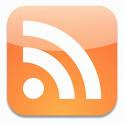 In the course of your online adventures, you may have already come across such terms, as "RSS", "Atom", "Syndication Feed", and others similar. You may have wondered what they meant and why you needed to care about them. The explanations for these terms are freely available on the web and are easy to find. I have put together this quick primer to skip over the technical details, but instead to try to convey to a non-too-tech savvy user what sort of technology these terms stand for and why they are important in today's web. I have also wanted to do this to "soften" some ground for the next few HOW-TO installments in this blog, as most of them will deal with RSS in some form or another.
In the course of your online adventures, you may have already come across such terms, as "RSS", "Atom", "Syndication Feed", and others similar. You may have wondered what they meant and why you needed to care about them. The explanations for these terms are freely available on the web and are easy to find. I have put together this quick primer to skip over the technical details, but instead to try to convey to a non-too-tech savvy user what sort of technology these terms stand for and why they are important in today's web. I have also wanted to do this to "soften" some ground for the next few HOW-TO installments in this blog, as most of them will deal with RSS in some form or another.For a regular user, the differences between RSS and Atom are not important. What's important is that both are standards regarding how to format a "List of Items". The format says how to describe the "List" itself, and then each "Item". This formatted List then can be accessed through a URL, usually by clicking on that well-recognizable symbol (and very much like any regular web page).
The "List" information, among many other things, should contain:
- Title
- URL of the website where the List originates
- Published Date
- Author
Each "Item" information, among other things, should contain:
- Title
- Description (can include images, video, etc)
- URL of the website where the Item can be found
- Published Date
Pretty simple, isn't it? Ok, let's try to see how many different types of information these formats can easily describe.
1. Can they describe blogs? Sure, and that's what they are used for a lot! Each blog posting ("Item") can be easily described through a Title, Description, URL, and Date. The blog itself ("List") can be also described through a Title, URL and Date. (In case you are wondering, your MyRealPage Blogs automatically get RSS feeds).
2. How about your Property Listings? Yes, actually. Your listings are obviously a "List" (even if there is only one or no listings). Each listing can also be easily described through a Title (say, listing's addess), Description (listing's details), URL (where to find the full web page on the listing).
3. How about your Testimonials? Hm, yes, indeed. You can easily apply the logic from the listing to describe a Testimonial: a Title can be the happy customer's name, Description can the content of the Testimonial, and the URL can be either skipped or point to your Testimonials page on your website.
4. So, how about, favorite quotes, cooking recipes, useful links, reports? Yes, and you should get the picture by now.
So, the next question is why should you care about all this?
Well, simply put, both RSS and Atom are a great way to read and stay up to date with changes in a particular "List". Most modern browsers will allow you to access an RSS or Atom feed directly and display well formatted results too! Every time you refresh, you get the updated list. Browsers find it easy to read these feeds because they "understand" the format, for example, they know where each "Item" begins, where each "Description" is, etc.
Then, enter Feed (RSS) Readers... These allow you to organize all your favorite feeds in one place, much alike favorite links in your browser, and the Feed (RSS) Reader will update all of them when you click to see new updates.
If you are interested, I strongly encourage you to check out Google Reader (http://www.google.com/reader). It will display all your feeds in a web page, and I even use it on my phone. If you already have a gmail account, you can start using it right away. If not, create a google account; it's very quick and simple. Google Reader is a great way to start experimenting with feeds or to organize your existing ones. (As an exercise, try to add this blog to your new Google Reader account, if you don't have one yet).
Stay tuned to the next few installments on this blog, as well as MyRealPage Company Blog http://www.myrealpage.com/blog.html too. They will be exploring the RSS in a traditional, and not so tranditional way.
No comments:
Post a Comment